 |
Focus features two in-depth reviews each month of fine art, architecture and design exhibitions and events at art museums, galleries and alternative spaces around Japan. The contributors are non-Japanese art critics living in Japan. |
|
|
 |
 |
 |
Reviving Islands through Art: The Setouchi Triennale
Lucy Birmingham |
 |
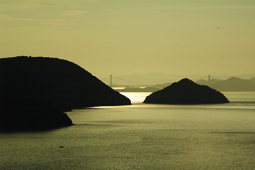 |
|
 |
|
|
|
| Views of the Seto Inland Sea and islands. |
"I'm sure you want to eventually reach paradise, but assume it'll be after you die," says billionaire art patron Soichiro Fukutake. "My dream," he adds, "is to create paradise while we're still alive." Indeed he has, I think with a smile, as I recall my recent trip to the 2013 Setouchi Triennale, a contemporary art festival he is quietly supporting with his personal fortune and foundation. Unique among art events, it is aimed at reviving the aging and depopulating local communities that host it.
Running until November 4, the Triennale takes place on a small cluster of 12 "art islands" at the eastern end of the narrow, 450-kilometer Seto Inland Sea (Setonaikai) that extends from Osaka and Kobe to Kyushu. Artworks showing just for the Triennale range from the magical to the mediocre and are divided among three sessions - spring, summer and autumn. Also on view are permanent works and museums, some of them brand new.
Fukutake had long been witness to the Setouchi islands' economic decline as head of nearby Okayama-based Benesse Holdings, a highly successful correspondence education and publishing group. In the 1980s, inspired by his art-collecting father, he hit on the idea of community revival through art tourism. He has since been the enduring backer and promoter of the Setouchi art project, which began with his vision for the island of Naoshima, a short train and ferry ride from Okayama.
 |
|
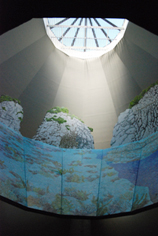 |
|
|
|
| Wang Wen Chih, Scenery of the Islands, 2012-13, Shodoshima. Made of 5,000 island-grown bamboo strips and built at the foot of a slope of terraced fields, the structure is lit up at night by LEDs. |
|
Kana Yoshida, The Secret of Hanasuwajima. Hanasuwajima is a tiny uninhabited island off the shore of Shodoshima. Shaped like an inverted cone, the work depicts the small, wave-eroded island rising from the bottom of the sea. |
The 2013 Triennale and its 2010 predecessor have been an experimental fusion of art and community. Elderly local residents, municipal and prefectural governments, thousands of volunteers, students from abroad, international foundations, and artists worldwide have collaborated on hundreds of projects and events. But there have also been clashes. Not all locals have been willing participants, and it has taken years of persuasion to get communities on board. "The local residents may not understand the art," says Triennale director Fram Kitagawa, "but they can see it's helping improve the economy, and many are now happy to get involved."
I was introduced to the Seto region through Donald Richie's classic The Inland Sea, first published in 1971. From this late, great chronicler I learned the islands were once a travel destination for ancient VIPs like Jimmu Tenno, Japan's legendary first emperor. It's said that an early form of Shinto took root there, and the region has been the seat for mythical emissaries such as the goddess Benten, protector of the seas. The islands have also been the inspiration for timeless tales such as that of Urashima Taro, Japan's Rip Van Winkle. The Seto Inland Sea was once the nation's mercantile crossroads, attracting traders, pirates, and voyagers from faraway lands centuries ago. But Richie also wrote of the area's modern maladies: environmental damage from industrial waste and copper refineries emitting sulfur dioxide; a low birth rate; and an isolated, aging population.
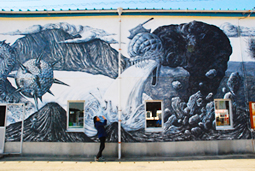 |
|
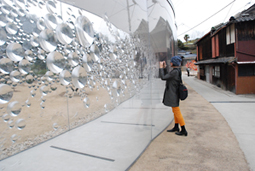 |
|
|
|
| Wall mural depicting a sculpture by Kenji Yanobe and Beat Takeshi titled Anger from the Bottom, Shodoshima. Takeshi drew up the plan while Yanobe arranged and created the sculpture, which represents a huge, fearsome land spirit. |
|
Haruka Kojin, contact lens, 2010, Inujima. |
The pollution is now long gone and the islands pristine, but important reminders remain, including a must-see destination on the island of Inujima. Architect Hiroshi Sambuichi has transformed the remains of an infamous copper refinery -- used to fuel Japan's military buildup in the early 1900s -- into an underground, ecologically sustainable museum. Installations there by artist Yukinori Yanagi incorporate the writings and home of renowned author and nationalist Yukio Mishima.
A short walk away on this small island is the Inujima Art Project, which brings together Pritzker Prize-winning architect Kazuyo Sejima and art director Yuko Hasegawa. This dynamic duo has collaborated on four structures that display works by Kohei Nawa (sculpture), Haruka Kojin (colorful paper cutouts and clear acrylic lenses), Jun Nguyen-Hatsushiba (an art film/documentary on the island's once famous granite industry), and Yukinori Maeda (a sound/light installation).
Nearby is Yusuke Asai's mythical floor mural, filling a plot among old wooden houses. Titled Listen to the Voices of Yesterday Like the Voices of Ancient Times, the work celebrates the islanders' stories embedded in time.
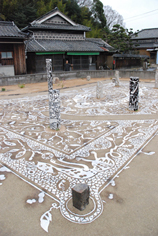 |
|
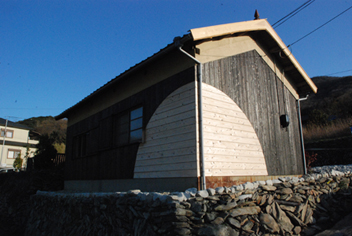 |
|
|
|
| Yusuke Asai, Listen to the Voices of Yesterday Like the Voices of Ancient Times, 2013, Inujima. The sheets of heat-applied thermoplastic material are normally used for white road markings. |
|
James Jack, Sunset House: Language as the House of Being, 2012-13, Shodoshima. |
The island of Naoshima, well off the usual art-tourist track of Tokyo and Kyoto, has gained fame among art and architecture enthusiasts worldwide. It was the first of Fukutake's art and community endeavors. He commissioned celebrated architect Tadao Ando to design Benesse House (a museum with hotel facilities) and the partially-underground Chichu Art Museum (2004), which houses a world-class collection of art including works by Hiroshi Sugimoto, Cy Twombly, James Turrell, and Claude Monet. Ando has also designed the Lee Ufan Museum (2010) and his own, newly opened Ando Museum in the island's Honmura village.
Honmura hosts the unique Art House Project, where installations have transformed old houses in quaint, tightly knit neighborhoods. Tatsuo Miyajima's three works were the first to appear, in 1998. His Sea of Time '98 captivates with 125 LED digital counters placed in dark shallow water. Others include Yoshihiro Suda's delicate, wood-carved camellia flowers, Gokaisho (2006); Hiroshi Senju's Nihonga-style paintings Garden of Ku (2009) and The Falls (2006); and Shinro Ohtake's junkyard splendor Haisha (2006), a former dentist's home. At Ohtake's sento (public bath), built in 2009 near the island's Miyanoura Port, visitors are welcome to join the locals in the steaming hot water.
 |
|
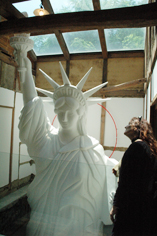 |
|
|
|
| Left to right: Soichiro Fukutake (Triennale patron), Lee Ufan (artist), and Fram Kitagawa (Triennale director) at the Lee Ufan Museum, Naoshima, designed by Tadao Ando. |
|
Shinro Ohtake/graf, Haisha, 2010, Naoshima. |
Teshima island, while equally captivating, requires much more effort and time to get to. Must-sees include the Teshima Art Museum (2010) by architect Ryue Nishizawa (Sejima's SANAA partner and fellow Pritzker Prize-winner) in collaboration with artist Rei Naito. Designed like a water drop, the structure echoes both science fiction and the sacred.
Mariko Mori's three-meter-high Tom Na H-iu, a sculptural light installation, inspires much the same sensation. Placed at the center of a pond surrounded by forest, the work is said to be connected with the Institute for Cosmic Ray Research at the University of Tokyo.
Near the island's port is the new Teshima Yokoo House, a museum of works by pop art icon Tadanori Yokoo. Architect Yuko Nagayama has combined a trio of century-old residences to create a public gallery and private funeral space for local residents. The project reflects Yokoo's long-time fascination with death as a companion to life, as well as his colorful sense of humor.
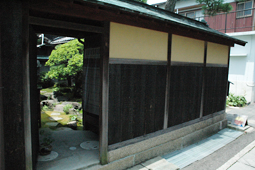 |
|
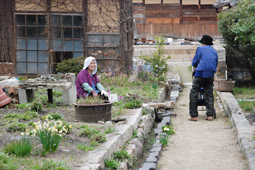 |
|
|
|
A private home with a lovely Japanese garden in the village of Honmura, Naoshima.
|
|
Elderly residents of Inujima. |
Shodoshima, one of the largest islands in the Inland Sea, also offers a plenitude of works. One of my favorites is the eye-catching Scenery of the Islands by Taiwanese artist Wang Wen Chih, inspired by the island's kabuki theater tradition and seasonal beauty. The domed structure is made of sturdy bamboo strips and sits at the base of terraced rice paddies, verdant green in late summer. Another work melding art, nature and community is Sunset House: Language as the House of Being by Tokyo-based American artist James Jack. Jack renovated the community lounge once used by stone quarry workers, with the written thoughts, frustrations, and dreams of local residents incorporated within the walls.
Other highlights include Kana Yoshida's The Secret of Hanasuwajima (a deep-sea inverted cone painting); Masashi Echigo's There is no smoke without fire (inspired by the island's tobacco farming); Kenji Yanobe's The Star Anger (a giant star-like sculpture topped by a fearsome dragon); Yanobe's warehouse wall mural nearby; and Yanobe's Anger from the Bottom, a frightening giant land spirit created in collaboration with Japanese TV talent and film director Beat Takeshi.
"When I began visiting the islands in the mid-1980s I started to think, what is true happiness? What is true prosperity?" says Soichiro Fukutake. "I realized that true happiness is only possible when you live in a happy community . . . with elderly people who are always smiling." While many challenges remain for the local residents, Fukutake is indeed realizing his dream of paradise: the happy communities that can now be found among the art islands of the Seto Inland Sea.
Note: Getting to and around the islands takes considerable planning. After several near misses with ferries, local boats and buses -- as well as taxis requiring reservations -- I learned that a guided tour of the art islands is the best way to optimize one's trip.
|
|
|
 |
Setouchi Triennale 2013 |
 |
Naoshima, Inujima, Teshima, Shodoshima and other islands in the Seto Inland Sea
|
 |
20 March - 21 April, 20 July - 1 September, and 5 October - 4 November 2013
|
|
|
 |
 |
Lucy Birmingham
Lucy Birmingham is a long-time, Tokyo-based journalist, scriptwriter, author, and former photojournalist. She writes regularly for TIME magazine and her articles have appeared in many publications, including the Wall Street Journal, Newsweek, Bloomberg News, and Architectural Digest. As an arts and culture writer her articles have appeared in publications including Artinfo.com, Artforum.com, and ARTnews. She is also a scriptwriter and narrator for NHK (Japan's public broadcaster) and has published several books including Strong in the Rain: Surviving Japan's Earthquake, Tsunami, and Fukushima Nuclear Disaster.
lucybirmingham.com |
|
 |
|